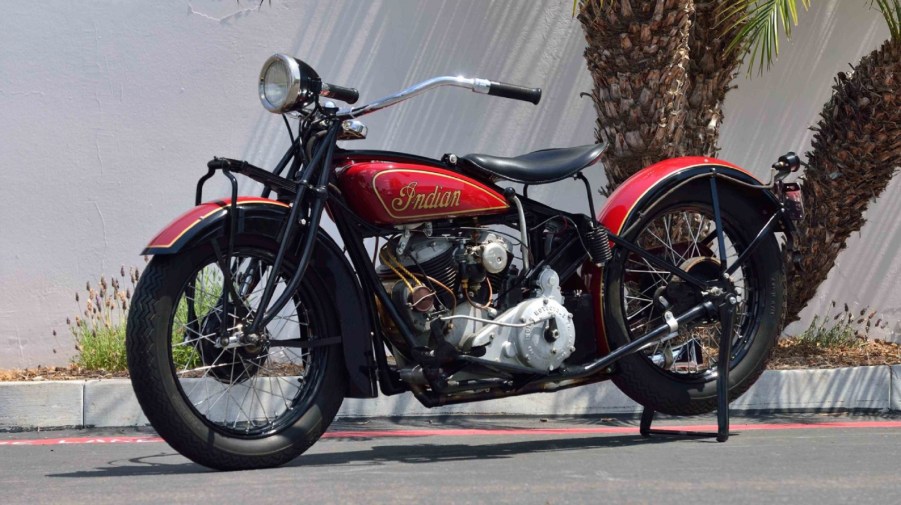
This Is Why the Original Indian Scout Is a Classic Motorcycle Icon
If you’re looking for an inexpensive modern cruiser, the Indian Scout and Scout Sixty are a great place to start. The latter has been bobbed and even out-fitted for jungle expeditions. But like the Triumph Bonneville, the Indian Scout has an extensive back-story. And much like the Bonneville, the original Scouts are still regarded as classic motorcycle icons.
The Indian Scout’s history
When Indian started in 1897, it was a bicycle company, not a motorcycle one. But 4 years later, it started supplying motorized bicycles to serve as pace vehicles. And by 1907, Indian was a proper motorcycle company, with the first American production V-twin.
The first Indian Scout came in 1920. And for its time, it was a fairly advanced motorcycle, Silodrome reports. Instead of a chain, gears linked the 610cc V-twin to the 3-speed hand-operated transmission. Although it lacked rear suspension—common for the time—the Scout’s double-loop cradle frame was both light and strong, MotorcycleClassics reports. Combined with the robust and torquey engine, it quickly became a favorite with hill climbers, flat trackers, and stunt riders, Silodrome reports.

By 1927, the Indian Scout had a new 745cc V-twin. But the competition was catching up or surpassing the classic motorcycle. Its most significant rivals were Excelsior and Henderson, with their four-cylinder and large-capacity V-twins.
To help the Scout keep up, Indian turned to its racer-turned-engineer, Charlie B. Franklin. The Irish immigrant had already won 2nd place in the 1911 Isle of Man TT for Indian, Silodrome reports. Other Indian riders placed 1st and 3rd that year, too. Franklin raced earlier Scout models as well, RideApart reports. And he’d helped the motorcycle company improve the design and power output of its flathead engines.
Why the Indian 101 Scout is a classic motorcycle legend
His creation was the 1928-1931 Indian 101 Scout. And while the Scout continued for a brief time after WWII, Rider reports, the 101 is the most iconic of these classic motorcycles. Many consider it the best bike the original Indian company ever made, Motorcyclist reports.

Compared to the original Indian Scout, the 101 has a longer and lower frame, Mecum reports. It also has a front brake as well as an increased fork angle. As a result of all this, the Indian 101 Scout was even more stable and better-handling than the original.
Plus, its 745cc V-twin had plenty of low-end torque. It can chug along happily at low speeds on a rutted field in top gear but still accelerate quickly to cruising speed. More to the point, it could ride over that field comfortably, thanks to its sprung seat. That’s another reason why the Indian Scout was so well-regarded in the days before widespread paved roads. The foot-operated clutch and hand-shifting take some getting used to, though.
It’s also incredibly reliable, owner Jay Leno reports, partially thanks to that gear-driven primary drive. Indian sold the bike with the tagline, “You just can’t break an Indian Scout.” Indeed, even almost 100 years later, the 101 Scout still participates in ‘Wall of Death’ events.
And although Bessie Stringfield, the first Black woman to cross the US on a motorcycle, owned 27 Harley-Davidsons in her lifetime, her very first bike was a 1928 Indian Scout, Iron & Air reports. She actually learned how to ride on that Scout, and she used that bike on her historic 1930 trip, RideApart reports.
Getting one today
Unfortunately, the Great Depression and Indian’s financial troubles meant a brief production run for the 101 Scout. And afterward, cost-saving measures meant it received the same heavy frame as the contemporary Chief.
However, the 1934 Indian Sport Scout was a return to form, Silodrome reports. At 385 pounds, it was 15 pounds heavier than the 101. However, its 750cc V-twin is more powerful and comes with pressurized oil lubrication, rather than a total-loss system. And in 1937, Ed Kretz won the first-ever Daytona 200 on a Sport Scout.
As a result of their rarity and historical status, these classic motorcycles can be somewhat pricey. However, they’re not quite at Pierce-Arrow Four or Brough Superior levels.

Although a pristine Indian 101 Scout can go for about $70k, a good-condition one can be found for $20k-$25k, Hagerty reports. The later Sport Scouts are a bit cheaper, Hagerty reports, with even the best-kept models topping out at about $40,000. As of this writing, there’s a 1939 example listed on Bring a Trailer for $9000.
Follow more updates from MotorBiscuit on our Facebook page.


